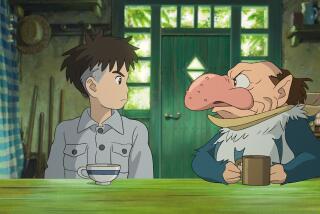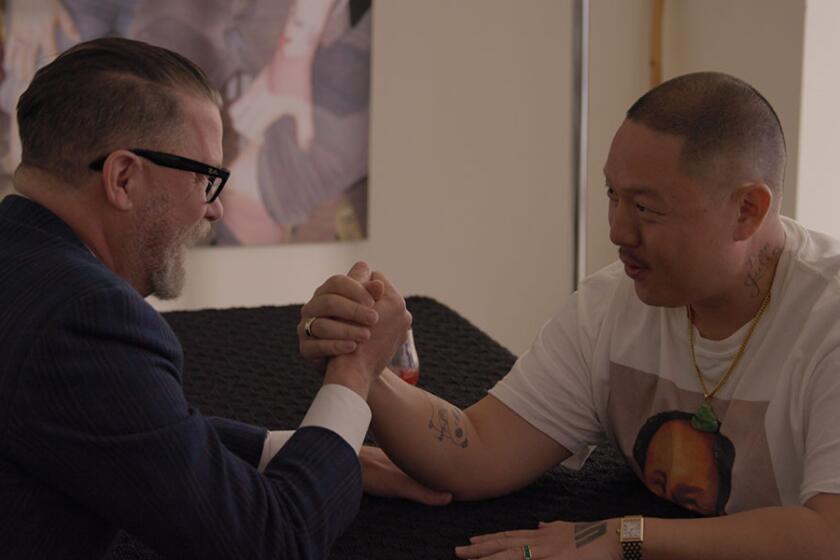‘Gremlins’ ’ Joe Dante: The Boy Can’t Help It : Movies: The director’s creatures have gobbled up box offices worldwide. His explanation: ‘I grew up watching cartoons and I have a cartoon sensibility.’
I worried always that this movie would be too cute. --Director Joe Dante, 1984, on “Gremlins”
Well, this one is even more cute. --Dante, 1990, on “Gremlins 2: The New Batch”
Has Joe Dante, a graduate of the Roger Corman school of exploitation filmmaking, gone soft?
The original script for Dante’s “Gremlins” had the malevolent title beasties chewing up the family dog, not to mention gnawing off the head of the hero’s mother and bouncing it down the stairs. But over the course of production, what started out as a grisly supernatural thriller took a less violent and far more comic turn, with mom and dog emerging unscathed and the body count sufficiently reduced to get a PG rating.
Six years later, there is scarcely any horror left in the formula. “Gremlins 2” is an action slapstick comedy that Dante intended for small fry and adults alike. The film opened Friday to generally good reviews and grossed $9.7 million.
“A lot of times parents have to bring kids to pictures that the kids love and they find boring,” Dante says. “And other times parents bring kids to pictures that are totally inappropriate because they can’t afford a baby sitter. I saw ‘Total Recall’ this weekend with whole families there, with very little kids watching this movie that is not what you’d call a children’s film. But this, I think, bridges the gap.”
“Gremlins 2” contains an abundance of the sort of reflexive movie in-jokes that used to populate Tex Avery’s surrealistic animated shorts in the ‘40s and ‘50s. At one point the film even appears to stop as mischievous gremlins take over the projection booth to show an old black-and-white nudie-cutie in place of a Tex Avery cartoon.
“All that self-referential stuff, that Pirandellian stuff where you realize you’re watching a movie, has all been pioneered in cartoons,” says Dante, a consummate film buff whose disheveled hair and manic manner suggest a friendly uncle parents might think twice about leaving the kids with.
“I grew up watching cartoons and I have a cartoon sensibility. I think some of the cartoons that Avery and Chuck Jones and Frank Tashlin directed are fully as major achievements as many features. And they are all directed, just like a feature is directed, although with a little more elasticity. And Tashlin went on to make some remarkable live-action pictures--the Bob Hope pictures and the Martin and Lewis pictures and ‘The Girl Can’t Help It,’ which is an astounding relic of the ‘50s.
“But then as his career went on, he found it difficult to repeat that kind of thing. I’ll always have a certain animated sensibility to the things that I do because it’s a type of humor that makes me laugh, but I hope my next picture is not as deliberately cartoony as this picture is.”
Dante first made his name as a director with straight horror films, if straight isn’t too strong a word for them. The successful low-budget efforts “Piranha” (a “Jaws” knockoff made for mentor Corman) and “The Howling” (a werewolf tale that has spawned several sequels) had plenty of tongue-in-cheek moments, but the terror, at that point, still dominated the humor.
The balance finally tipped toward the other side of the scale on the set of “Gremlins.”
“That had begun as a horror film, and our original task was to make a scary, gruesome movie. And then as we worked with the gremlins and realized how funny and how satirical of human beings they were, we pushed the absurdities of the plot into a more comic vein, which I think made the difference between a movie that made just a little bit of money and one that made a lot of money”--more than $200 million worldwide, in fact, placing it among the top 25 grossers of all time.
Dante has been showing a softer side in recent years, instilling such films as “Explorers” and “Innerspace” with childlike wonder while turning down repeated offers to make a sequel to “Gremlins.”
A number of writers cooked up ideas in his absence, including one script titled “Gremlins Go to Vegas.” When Dante finally agreed to direct a sequel, he jettisoned that concept (“What is there to wreck in Las Vegas except a very boring town nobody really much cares about?”) and brought in writer Charlie Haas to help craft a screenplay in which the nasties infiltrate a Trump Tower-like skyscraper in New York.
Early on, Dante enticed creature effects maestro Rick Baker, who did not work on the first movie, with the promise that any ideas he might come up with for new gremlins could be incorporated into the script. The genetic-splicing lab run by Christopher Lee in which a number of the creatures mutate was Baker’s idea.
Says Dante: “We decided that two of our gremlins would be George and Lenny ‘Of Mice and Men’ types, which are very familiar to cartoon watchers, because there’s always the smart little dog and the big dumb dog. So we started looking at old Warners cartoons trying to find some gags that we could use for them, but virtually all of them were verbal jokes, and these two gremlins didn’t talk.”
So, from there, Dante went on to screen silent film comedies by Keaton and Chaplin to pick up more ideas for purely visual gags.
Limitations in the gremlins’ design put the kibosh on some ideas. “For instance, we thought that originally Gizmo (the sympathetic Mogwai creature), instead of watching Rambo movies, would watch Bruce Lee movies, and that he would kung-fu the gremlins and use nunchaku sticks. When we came to our senses, we realized that since Gizmo’s arms don’t even reach to his head, and when he kicks he can’t kick more than of an inch in front of him, we were just kidding ourselves.
“We had to go back and re-tailor this grandiose script to the realities of what could actually be done with the gremlins. We had single jokes that would have cost immense amounts of money to do. The spirit of compromise hovers heavily over the movie.”
Tell that to Warner Bros., which invested an estimated $30 million in the production. Compromise or no, the movie is chock-full of seemingly expensive gremlin crowd scenes, culminating in a lavish, Busby Berkeley-style musical production number.
The studio’s collective mind was no doubt set at ease by the rave reviews in both of Hollywood’s daily trade papers, but ever since the baffling commercial failure of “Innerspace,” Dante is wary of early prognostications. “Innerspace” got great marks at preview screenings and opened to generally good reviews, only to flounder at the box office. His last film, “ The ‘burbs,” was savaged by the majority of critics yet became a commercial hit.
Critics of “Gremlins 2” may be more put-off by the number of brand-name product plugs included. It is at least ironic that a film satirizing the corporate world of a Donald Trump-type tycoon seeks to simultaneously exploit it.
“That corporate tie-in thing comes from an actual need to try to represent some kind of reality,” says Dante in defense. “We have a mall set that’s like the inside of Trump Tower, and each one of those stores has to look like a real store. Now, we could make up names for stores, but it wouldn’t have any recognition value for the audience. And we wouldn’t get to do jokes like having U-Haul on the second floor.”
So, in typical Dante fashion, the movie mocks itself. “We made the movie and we still make fun of it,” he says. “We didn’t draw the line; we make fun of just about anything.”
His targets even include the film’s potential merchandising bonanzas. At one point in the film, an entrepreneurial character suggests that the adorable little Gizmo would make a great doll--an idea that occurred to Warner Bros. years ago.
Says Dante: “Even the movie comments on the movie. Doing interviews about it seems redundant.”
More to Read
Only good movies
Get the Indie Focus newsletter, Mark Olsen's weekly guide to the world of cinema.
You may occasionally receive promotional content from the Los Angeles Times.










